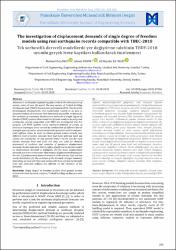| dc.contributor.author | Demir, Ahmet | en_US |
| dc.contributor.author | Kayhan, Ali Haydar | en_US |
| dc.contributor.author | Palancı, Mehmet | en_US |
| dc.date.accessioned | 2021-07-13T11:44:56Z | |
| dc.date.available | 2021-07-13T11:44:56Z | |
| dc.date.issued | 2021 | en_US |
| dc.identifier.citation | Palanci, M., Demir, A., & Kayhan, A. H. The investigation of displacement demands of single degree of freedom models using real earthquake records compatible with TBEC-2018. Pamukkale Üniversitesi Mühendislik Bilimleri Dergisi, 27(3), 251-263. | en_US |
| dc.identifier.issn | 1300-7009 | |
| dc.identifier.issn | 2147-5881 | |
| dc.identifier.uri | https://doi.org/10.5505/pajes.2020.47936 | |
| dc.identifier.uri | https://hdl.handle.net/20.500.12294/2782 | |
| dc.description.abstract | Advances in earthquake engineering play a role in the development of seismic codes all over the world. The new version of Turkish Building Earthquake Code (TBEC) has also been published in 2018. Thanks to the technological developments, real acceleration records to be used in dynamic analysis of structures have been easily accessible. In this study, the variation of maximum displacement demands of single degree of freedom (SDOF) systems determined via dynamic analysis by using real earthquake records compatible with TBEC are investigated. For this purpose, 120 SDOF systems which represent behavior of variety of structural topologies were created by combination of different lateral strength capacity ratios, structural periods, hysteretic models and post-yield stiffness ratios. In order to obtain ground motion records, two different level of seismic intensity level and three different local soil classes are considered. 30 real ground motion record sets for each seismic intensity level and local soil class are used for detailed assessment of tendency and variation of maximum displacement demands. Results indicated that (a) effect of different hysteretic models on displacement demands is negligible, (b) the mean displacement demands are more conservative than median displacement demands for the sets, (c) displacement demand variation of the sets are high and not evenly distributed, (d) the variation of the demands changes randomly depending on local soil class and earthquake level, (e) lateral strength ratio and post-yield stiffness are efficient on the variation of the demands. | en_US |
| dc.language.iso | eng | en_US |
| dc.publisher | Pamukkale University | en_US |
| dc.relation.ispartof | Pamukkale University Journal of Engineering Sciences-Pamukkale Universitesi Muhendislik Bilimleri Dergisi | en_US |
| dc.identifier.doi | 10.5505/pajes.2020.47936 | en_US |
| dc.identifier.doi | 10.5505/pajes.2020.47936 | |
| dc.rights | info:eu-repo/semantics/openAccess | en_US |
| dc.subject | Single Degree of Freedom Models | en_US |
| dc.subject | Real Ground Motion Record Selection | en_US |
| dc.subject | Dynamic Analysis | en_US |
| dc.subject | Turkish Building Earthquake Code | en_US |
| dc.title | The Investigation of Displacement Demands of Single Degree of Freedom Models Using Real Earthquake Records Compatible With Tbec-2018 | en_US |
| dc.type | article | en_US |
| dc.department | Mühendislik ve Mimarlık Fakültesi, İnşaat Mühendisliği Bölümü | en_US |
| dc.authorid | 0000-0002-9223-5629 | en_US |
| dc.identifier.volume | 27 | en_US |
| dc.identifier.issue | 3 | en_US |
| dc.identifier.startpage | 251 | en_US |
| dc.identifier.endpage | 263 | en_US |
| dc.relation.publicationcategory | Makale - Uluslararası Hakemli Dergi - Kurum Öğretim Elemanı | en_US |


















